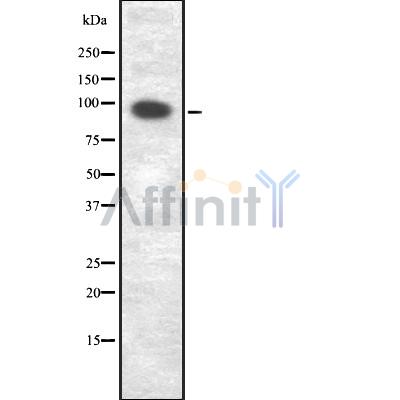ADAM15 Antibody - #DF8350
| 製品: | ADAM15 Antibody |
| カタログ: | DF8350 |
| タンパク質の説明: | Rabbit polyclonal antibody to ADAM15 |
| アプリケーション: | WB IHC |
| 反応性: | Human, Mouse, Rat |
| 予測: | Pig, Bovine, Horse, Sheep, Rabbit, Dog |
| 分子量: | 93 kDa; 93kD(Calculated). |
| ユニプロット: | Q13444 |
| RRID: | AB_2841615 |
製品説明
*The optimal dilutions should be determined by the end user.
*Tips:
WB: For western blot detection of denatured protein samples. IHC: For immunohistochemical detection of paraffin sections (IHC-p) or frozen sections (IHC-f) of tissue samples. IF/ICC: For immunofluorescence detection of cell samples. ELISA(peptide): For ELISA detection of antigenic peptide.
引用形式: Affinity Biosciences Cat# DF8350, RRID:AB_2841615.
折りたたみ/展開
A disintegrin and metalloproteinase domain 15 (metargidin); A disintegrin and metalloproteinase domain 15; ADA15_HUMAN; ADAM 15; ADAM metallopeptidase domain 15; Adam15; and cysteine-rich protein 15; Disintegrin and metalloproteinase domain-containing protein 15; disintegrin-like; EC 3.4.24.; MDC 15; MDC-15; MDC15; Metalloprotease RGD disintegrin protein; Metalloproteinase like disintegrin like and cysteine rich protein 15; Metalloproteinase-like; Metargidin;
免疫原
Expressed in colon and small intestine. Expressed in airway smooth muscle and glomerular mesangial cells (at protein level). Ubiquitously expressed. Overexpressed in atherosclerotic lesions. Constitutively expressed in cultured endothelium and smooth muscle. Expressed in chondrocytes. Expressed in airway smooth muscle and glomerular mesangial cells.
- Q13444 ADA15_HUMAN:
- Protein BLAST With
- NCBI/
- ExPASy/
- Uniprot
MRLALLWALGLLGAGSPLPSWPLPNIGGTEEQQAESEKAPREPLEPQVLQDDLPISLKKVLQTSLPEPLRIKLELDGDSHILELLQNRELVPGRPTLVWYQPDGTRVVSEGHTLENCCYQGRVRGYAGSWVSICTCSGLRGLVVLTPERSYTLEQGPGDLQGPPIISRIQDLHLPGHTCALSWRESVHTQKPPEHPLGQRHIRRRRDVVTETKTVELVIVADHSEAQKYRDFQHLLNRTLEVALLLDTFFRPLNVRVALVGLEAWTQRDLVEISPNPAVTLENFLHWRRAHLLPRLPHDSAQLVTGTSFSGPTVGMAIQNSICSPDFSGGVNMDHSTSILGVASSIAHELGHSLGLDHDLPGNSCPCPGPAPAKTCIMEASTDFLPGLNFSNCSRRALEKALLDGMGSCLFERLPSLPPMAAFCGNMFVEPGEQCDCGFLDDCVDPCCDSLTCQLRPGAQCASDGPCCQNCQLRPSGWQCRPTRGDCDLPEFCPGDSSQCPPDVSLGDGEPCAGGQAVCMHGRCASYAQQCQSLWGPGAQPAAPLCLQTANTRGNAFGSCGRNPSGSYVSCTPRDAICGQLQCQTGRTQPLLGSIRDLLWETIDVNGTELNCSWVHLDLGSDVAQPLLTLPGTACGPGLVCIDHRCQRVDLLGAQECRSKCHGHGVCDSNRHCYCEEGWAPPDCTTQLKATSSLTTGLLLSLLVLLVLVMLGASYWYRARLHQRLCQLKGPTCQYRAAQSGPSERPGPPQRALLARGTKQASALSFPAPPSRPLPPDPVSKRLQAELADRPNPPTRPLPADPVVRSPKSQGPAKPPPPRKPLPADPQGRCPSGDLPGPGAGIPPLVVPSRPAPPPPTVSSLYL
種類予測
Score>80(red) has high confidence and is suggested to be used for WB detection. *The prediction model is mainly based on the alignment of immunogen sequences, the results are for reference only, not as the basis of quality assurance.
High(score>80) Medium(80>score>50) Low(score<50) No confidence
PTMs - Q13444 基板として
| Site | PTM Type | Enzyme | Source |
|---|---|---|---|
| S56 | Phosphorylation | Uniprot | |
| K58 | Ubiquitination | Uniprot | |
| K59 | Ubiquitination | Uniprot | |
| K72 | Ubiquitination | Uniprot | |
| K400 | Ubiquitination | Uniprot | |
| K660 | Ubiquitination | Uniprot | |
| Y715 | Phosphorylation | P08631 (HCK) , P12931 (SRC) , P06239 (LCK) | Uniprot |
| K729 | Ubiquitination | Uniprot | |
| Y735 | Phosphorylation | P08631 (HCK) , P06239 (LCK) , P12931 (SRC) | Uniprot |
| S806 | Phosphorylation | Uniprot | |
| K814 | Ubiquitination | Uniprot | |
| K820 | Ubiquitination | Uniprot | |
| S832 | Phosphorylation | Uniprot |
研究背景
Active metalloproteinase with gelatinolytic and collagenolytic activity. Plays a role in the wound healing process. Mediates both heterotypic intraepithelial cell/T-cell interactions and homotypic T-cell aggregation. Inhibits beta-1 integrin-mediated cell adhesion and migration of airway smooth muscle cells. Suppresses cell motility on or towards fibronectin possibly by driving alpha-v/beta-1 integrin (ITAGV-ITGB1) cell surface expression via ERK1/2 inactivation. Cleaves E-cadherin in response to growth factor deprivation. Plays a role in glomerular cell migration. Plays a role in pathological neovascularization. May play a role in cartilage remodeling. May be proteolytically processed, during sperm epididymal maturation and the acrosome reaction. May play a role in sperm-egg binding through its disintegrin domain.
The precursor is cleaved by a furin endopeptidase.
Phosphorylation increases association with PTKs.
Endomembrane system>Single-pass type I membrane protein. Cell junction>Adherens junction. Cell projection>Cilium>Flagellum. Cytoplasmic vesicle>Secretory vesicle>Acrosome.
Note: The majority of the protein is localized in a perinuclear compartment which may correspond to the trans-Golgi network or the late endosome. The pro-protein is the major detectable form on the cell surface, whereas the majority of the protein in the cell is processed (By similarity).
Expressed in colon and small intestine. Expressed in airway smooth muscle and glomerular mesangial cells (at protein level). Ubiquitously expressed. Overexpressed in atherosclerotic lesions. Constitutively expressed in cultured endothelium and smooth muscle. Expressed in chondrocytes. Expressed in airway smooth muscle and glomerular mesangial cells.
Interacts with ITAGV-ITGB3 (vitronectin receptor). Interacts with SH3GL2 and SNX9; this interaction occurs preferentially with ADAM15 precursor, rather than the processed form, suggesting it occurs in a secretory pathway compartment prior to the medial Golgi. Interacts with ITAG9-ITGB1 (By similarity). Interacts specifically with Src family protein-tyrosine kinases (PTKs). Interacts with SH3PXD2A. Interacts with ITAGV-ITGB1. Interacts with GRB2, HCK, ITSN1, ITSN2, LYN, MAPK1, MAPK3, NCF1, NCK1, nephrocystin, PTK6, SNX33, LCK and SRC.
The cytoplasmic domain is required for SH3GL2- and SNX9-binding.
Disintegrin domain binds to integrin alphaV-beta3.
The conserved cysteine present in the cysteine-switch motif binds the catalytic zinc ion, thus inhibiting the enzyme. The dissociation of the cysteine from the zinc ion upon the activation-peptide release activates the enzyme.
Restrictive clause
Affinity Biosciences tests all products strictly. Citations are provided as a resource for additional applications that have not been validated by Affinity Biosciences. Please choose the appropriate format for each application and consult Materials and Methods sections for additional details about the use of any product in these publications.
For Research Use Only.
Not for use in diagnostic or therapeutic procedures. Not for resale. Not for distribution without written consent. Affinity Biosciences will not be held responsible for patent infringement or other violations that may occur with the use of our products. Affinity Biosciences, Affinity Biosciences Logo and all other trademarks are the property of Affinity Biosciences LTD.

